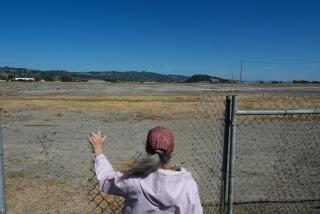Laguna OKs Major Flood Relief Project
The seaside enclave of Laguna Beach has long been a catch basin for inland urban runoff and flood waters that in years past have washed through its narrow village streets and swamped its business district and beaches.
Now, after nearly a decade of delay, city officials are plowing ahead with a $10-million project to build a wider underground flood channel, even as they learn that chemicals have pooled in the soil and ground water where most of the construction will take place.
Local environmentalists are demanding that city officials assess the publicâs risk from exposure to high levels of MTBE, benzene and other cancer-causing oil and gas derivatives. But council members, who voted unanimously last month to proceed, say they canât afford to lose $8.6 million and the manpower being donated by the U.S. Army Corps of Engineers and the Orange County Flood Control District.
On Nov. 20, council members rejected a request by city engineers for additional time to inform the public and work out logistical issues and extra costs of cleanup. Council members said that without the financial help, the channel would never be fixed, leaving lives and livelihoods at stake in the next flood season.
âIf we delay this for a year, weâre risking the safety of people of this town and businesses,â Councilman Wayne Baglin said. âLetâs not let this one slip through our fingers.â
Opponents, however, say too many critical issues are being overlooked in the fast-track approach.
âThere are a lot of dangerous unknowns about human health and safety, as well as potential impacts on the marine environment and the ecosystem,â said Marc Wright, chairman of the Laguna chapter of the Surfrider Foundation. âThe city doesnât have enough information to say with any credibility that any of those potential risks can be ruled out.â
Like a patient with clogged arteries, the city of 25,000 has always been anxious about going through with a $10-million repair, hoping to avoid the traffic diversions, noise, odors and other pains of tearing up the heart of downtown.
The existing channel, which carries flood waters from inland cities, is pinched by S-curves in Laguna Canyon, then doubles in carrying capacity to 1 million gallons a minute, only to narrow again to 360,000 gallons a minute before it ends at Main Beach. During heavy storms, water regularly backs up at drains near Beach Street, sending sand and silt through downtown. A few years ago, El Nino rains closed shops and restaurants, damaging the boardwalk and beach.
âWe must have spent hundreds of thousands of dollars cleaning mud off the sidewalks and buildings downtown,â Baglin said. âBusinesses closed down for several days. Weâre lucky we didnât lose people.â
To relieve the pressure points, a concrete box, 14 feet wide and 10 feet tall, would be built under Broadway, running about 450 yards from the bus depot, through the intersection with Coast Highway--the cityâs busiest thoroughfare, then out through the middle of Main Beach.
The current channel will be closed off when its replacement is complete.
To contain hazardous wastes, sheets of steel sunk as deep as 30 feet will surround construction zones. By means of sump pumps and screens, contaminated water would be treated on site to levels permissible for sewer systems and storm drain runoff. Contaminated soil would be stored temporarily at a city lot, then trucked to a landfill or recycling center.
Project Would Cause Traffic Snarls
The channel project, expected to take 18 months to 2 years to complete, is scheduled to begin by February, with relocation of sewer, telephone and power lines. Traffic would be reduced from three lanes to one on Broadway, and at Coast Highway, motorists would be routed around a small park at the beach. Work would be suspended during the summer tourist season.
County officials and the Army Corps of Engineers say there is evidence that the worst chemical plume is stable and even shrinking. They say the cleanup is manageable and note that the ground water in Laguna is not used for drinking anyway.
âItâs not like we discovered something in horrendously large quantities,â said Grigor Grigorian, project manager for the Corps. âPutting the project off only means downtown is going to be flooded again. . . . The solution is to do the project and mitigate. Itâs a fact we need to deal with. Itâs not a show-stopper.â
But environmentalists want more studies to determine where the plumes may have spread, or if construction could result in dispersing chemical contaminants.
They note that MTBE--methyl tertiary butyl ether, a carcinogen that can travel swiftly in ground water and doesnât degrade easily--is a big concern. Readings taken this year by county health officials were as high as 42,000 parts per billion in ground water near Coast Highway and Broadway. The state maximum allowable in drinking water is 13 parts per billion.
For decades a popular gasoline additive, MTBE is being phased out in California by 2003 because of its threat to health. The chemical is believed to have been spilled from underground tanks at nearby gasoline stations.
Betty Olson, a water pollution specialist who directs the Urban Water Research Center at UC Irvine, said the city should try to shield itself from potential cost and liability issues that could result.
The city and county are at odds over how the cleanup costs should be shared, with the city arguing that the county or third parties should pay. County officials are proposing that Laguna Beach pay for pollutants found on its property.
The city expects to hire a project manager soon and sort through the details of the first phase--the $1.4-million job of moving city sewer lines.
âIt will be tight, but we can get our part done,â City Manager Kenneth Frank said.
More to Read
Sign up for Essential California
The most important California stories and recommendations in your inbox every morning.
You may occasionally receive promotional content from the Los Angeles Times.










